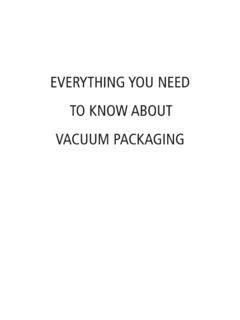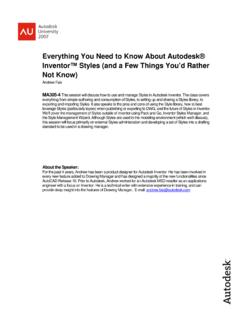Transcription of Everything You Need to Know Before You Buy or Build an ...
1 Everything You Need to know Before You Buy or Build an Aircraft Hangar. 2006 Erect-A-Tube, Inc. Table of Contents Introduction Section 1: Airport Environment Section 2: The Pre-Engineered Building Market Section 3: Determining the Correct Hangar Section 4: Hangar Doors Section 5: Sheeting Options Section 6: Roof Overhangs, Gutters and Downspouts Section 7: Building Codes Section 8: Foundations Moving Forward The Erect-A-Tube Story 2006 Erect-A-Tube, Inc. Introduction Congratulations! You have taken an important step in becoming more informed about the components and construction of aircraft hangars and door systems so that you can buy or Build the one that best meets your needs . Erect-A-Tube, Inc. with corporate offices based in Harvard, Illinois, has more than 40 years experience in the design and manufacture of aircraft hangars and door systems.
2 Our company has acquired a wealth of information working with numerous municipal airports, pilots, builders, developers, contractors and engineers to Build thousands of aircraft hangars across the United States and Canada. This reference guide is intended to provide you with a basic understanding and insight into the pre-engineered metal building industry and what to expect in your search for aircraft hangar manufacturers. It also provides information on the airport environment and definitions you will need to know . Ultimately, we hope this guide will help you make well-informed decisions on the road to constructing your hangar. Please note this booklet is not intended to offer you critical information on construction details, interpretation of building codes, construction techniques or related matters.
3 You may have additional questions after you read this guide. Experienced professionals at Erect-A-Tube many of whom are pilots can answer your questions and also provide additional information to help you make the right decisions. We will be continually improving and updating this guide, and would greatly appreciate your feedback and input. Please contact us at 1-800-624-9219. or send your comments to Be sure to visit us at to learn more about Erect-A-Tube and our quality aircraft hangars and hangar door systems. 2006 Erect-A-Tube, Inc. Section 1: Airport Environment Analyzing the market Whether you are an airport owner or someone who has an interest in developing hangars, determining the marketplace is the fundamental starting point.
4 Common questions in determining the market: Is there a need or demand for hangars? Does the airport have a waiting list of aircraft owners wanting a hangar? What are the rental rates of the hangars? What is the aircraft population within the area? Are there other airports within the vicinity? What are their rental rates? Do they have a waiting list? Some excellent websites to use in gathering data for your research: Once you have initially determined the market needs , putting together cost estimates is the second step to see if the project will really fly. Your analysis should include: Lease term and lease cost of the airport land Installing ramps and taxi lanes (if required by the airport). Bringing the utilities to the hangar site Hangar costs Construction costs Sales/use taxes Financing Vacancy factors Property or possessory taxes Maintenance 2006 Erect-A-Tube, Inc.
5 Owning and operating hangars versus developing For the airport, owning hangars can be an excellent source of revenue. In addition, each state's Department of Transportation may have grants or participatory funding to help offset the cost of infrastructure and the cost of hangar construction. Recently, the Federal Aviation Administration (FAA) announced that it will provide funding for hangar construction. Although there are caveats to this program, funding is available for most airports. For the private sector, owning and operating hangars can be a good investment if all of the costs can be met. An alternative is to develop and sell hangars as condominiums. This type of development can benefit the airport as well as those investing in their hangars.
6 Land leases The term for the land lease is determined by the airport owner. On average, the leases are 25 to 30 years in length. Many land lease agreements allow for term extensions at the option of the tenant. Although the majority of the negotiations are done at the airport management level, final approvals must be granted through the municipality that sponsors the airport, such as a city or county government. The lease rate is also determined by the airport owner on the basis of a square-foot measurement. Some airports just lease the land under the hangar footprint. Others include an additional 10 to 15 feet outside the building perimeter. Some larger airports will require the tenant to lease entire plots of land that encompass some or all the infrastructure.
7 Factors that should be addressed prior to leasing the parcel: Lease term and extensions Lease rate Determining the right location for the hangar Providing access to the taxi lanes and runways Drainage compliance Location and extension of the utilities Obtaining FAA Approval (see FAA 7460). 2006 Erect-A-Tube, Inc. Airport minimum standards The Airport Minimum Standards is the set of rules or policies that have been established by the airport owner regarding the minimum criteria that must be followed. Within this document, there will be a section that pertains to hangars. If the airport has established minimum standards, these standards should be referenced in the land lease. These standards may specify the building use group; building specifications; aesthetic criteria such as colors, roof pitch; and specific building guidelines, as well as the approval process.
8 Some common terms: (ALP) Airport Layout Plan is the plan of the airport showing the layout of existing and proposed facilities. (BRL) Building Restriction Line identifies suitable building locations on the airport. Distances between rows of hangars: FAA recommended formula: Door width X + 20 feet. Example: 40' (door width) X + 20 feet = 80 feet. FAA 7460: This is a reporting form that must be submitted and approved by the FAA prior to construction. This form details the location and height of the hangar to determine if any design corrections are required prior to construction. Refer to: 2006 Erect-A-Tube, Inc. Section 2: The Pre-Engineered Building Market Determining the differences doing your homework Some pre-engineered building manufacturers offer aircraft T-hangars and Consecutive Rectangular hangars; but the fact is there are only a select few manufacturers which offer the hangar and hangar door as an integrated system.
9 Therefore, you need to do your homework. The pre-engineered building market is very homogeneous. Although most metal buildings may look the same from the outside, unless you really inspect each manufacturer's product, it will be difficult to determine the quality differences between products. As with most purchases, it pays to understand the differences. Once the hangar purchase is made, any sacrifice in quality becomes apparent and lives on throughout the life of the product. Making the right choice returns dividends for many years through reliability, product longevity and ease of operation. At the end of Section 4 Hangar Doors there is a checklist. This checklist is important because it considers items that, as a buyer, you should look for as you compare building and hangar door systems.
10 Post-and-beam design Post-and-beam has long proven itself as a superior construction design for T-hangars and Rectangular hangars. This design combines a stronger, more durable structure, providing equal distribution of roof loads and maximum design flexibility for a variety of hangar models. Deflections are held to a minimum tolerance in comparison to a cantilever frame Utilizes smaller frame size Provides for lighter piers/foundation design, without any kick-out load Designed to carry both bi-fold and bottom rolling door systems 2006 Erect-A-Tube, Inc. Single source is better Erect-A-Tube's hangars and hangar doors are designed and manufactured as an integrated system providing single-source responsibility. This integrated system eliminates the design and assembly issues which can occur between matching various suppliers and their different configurations.







